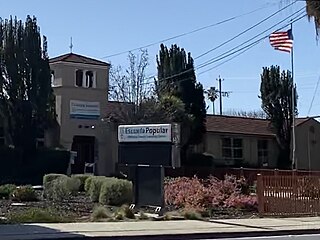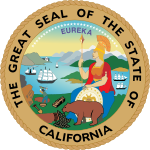In bilingual education, students are taught in two languages. It is distinct from learning a second language as a subject because both languages are used for instruction in different content areas like math, science, and history. The time spent in each language depends on the model. For example, some models focus on providing education in both languages throughout a student's entire education while others gradually transition to education in only one language. The ultimate goal of bilingual education is fluency and literacy in both languages through a variety of strategies such as translanguaging and recasting.
Language education – the process and practice of teaching a second or foreign language – is primarily a branch of applied linguistics, but can be an interdisciplinary field. There are four main learning categories for language education: communicative competencies, proficiencies, cross-cultural experiences, and multiple literacies.

Language immersion, or simply immersion, is a technique used in bilingual language education in which two languages are used for instruction in a variety of topics, including math, science, or social studies. The languages used for instruction are referred to as the L1 and the L2 for each student, with L1 being the student's native language and L2 being the second language to be acquired through immersion programs and techniques. There are different types of language immersion that depend on the age of the students, the classtime spent in L2, the subjects that are taught, and the level of participation by the speakers of L1.

The Elementary and Secondary Education Act (ESEA) was passed by the 89th United States Congress and signed into law by President Lyndon B. Johnson on April 11, 1965. Part of Johnson's "War on Poverty", the act has been one of the most far-reaching pieces of federal legislation affecting education ever passed by the United States Congress, and was further emphasized by the revised No Child Left Behind Act of 2001.
Transitional bilingual education is an approach to bilingual education in which students first acquire fluency in their native language before acquiring fluency in the second language, where fluency is defined as linguistic fluency as well as literacy. This is in contrast to total immersion bilingual education in which students are directly immersed in the second language. Transitional bilingual education is among those most commonly implemented in public schools across the United States. The application of transitional bilingual education in the United States ultimately resulted from an effort to officially recognize Chicano and Latino identities with the passage of the Bilingual Education Act.

French immersion is a form of bilingual education in which students who do not speak French as a first language will receive instruction in French. In most French-immersion schools, students will learn to speak French and learn most subjects such as history, music, geography, art, physical education and science in French.

Arizona Proposition 203, also known as English for the Children, is a ballot initiative that was passed by 63% of Arizona voters on November 7, 2000. It limited the type of instruction available to English language learner (ELL) students. Before Proposition 203, schools were free in terms of ELL instruction to use bilingual or immersion methods. According to a cover letter from the Arizona Department of Education Superintendent of Public Instruction Lisa Graham Keegan to the Arizona Legislature, it was impossible to make a correct analysis regarding how many students were learning through English as a second language programs, as opposed to bilingual education. The school districts had submitted "conflicting information," and 40% had not submitted any data, in spite of three deadline extensions.

The Bilingual Education Act (BEA), also known as the Title VII of the Elementary and Secondary Education Amendments of 1967, was the first United States federal legislation that recognized the needs of limited English speaking ability (LESA) students. The BEA was introduced in 1967 by Texas senator Ralph Yarborough and was both approved by the 90th United States Congress and signed by President Lyndon B. Johnson on January 2, 1968. While some states, such as California and Texas, and numerous local school districts around the country already had policies and programs designed to meet the special educational needs of elementary and secondary school students not fluent in the English language, this act signaled that the federal government now also recognized the need for and value of bilingual education programs in U.S. public education. In 1969 there was a 50% drop out rate among Mexican American students who struggled to keep up with their English-speaking peers in school; Representative Tony Abril argued that the Bilingual Education Act would reduce this number. Passed on the heels of the Civil Rights Movement, its purpose was to provide school districts with federal funds, in the form of competitive grants, to establish innovative educational programs for students with limited English speaking ability.
English-language learner is a term used in some English-speaking countries such as the United States and Canada to describe a person who is learning the English language and has a native language that is not English. Some educational advocates, especially in the United States, classify these students as non-native English speakers or emergent bilinguals. Various other terms are also used to refer to students who are not proficient in English, such as English as a second language (ESL), English as an additional language (EAL), limited English proficient (LEP), culturally and linguistically diverse (CLD), non-native English speaker, bilingual students, heritage language, emergent bilingual, and language-minority students. The legal term that is used in federal legislation is 'limited English proficient'.
Dual language is a form of education in which students are taught literacy and content in two languages. Most dual language programs in the United States teach in English and Spanish, but programs increasingly use a partner language other than Spanish, such as Arabic, Chinese, French, Hawaiian, Japanese, or Korean. Dual language programs use the partner language for at least half of the instructional day in the elementary years.
The English Language Acquisition, Language Enhancement, and Academic Achievement Act - formerly known as the Bilingual Education Act - is a federal grant program described in Title III Part A of the federal Elementary and Secondary Education Act (ESEA), which was reauthorized as the No Child Left Behind Act in 2002 and again as the Every Student Succeeds Act in 2015. This section is specifically targeted to benefit Limited English Proficient (LEP) children and immigrant youth. The statute states that LEP students must not only attain English proficiency but simultaneously meet the same academic standards as their English-speaking peers in all content areas. Federal funding is provided to assist State Education Agencies (SEAs) and Local Education Agencies (LEAs) in meeting these requirements. In 2011, ESEA Title III awards were granted to 56 SEAs and the average award given to an individual SEA was $12,158,046.
Mute English is a term coined in the People's Republic of China to describe a phenomenon where people cannot speak English well and have a poor listening comprehension as a second language, typically through the traditional method of English language teaching where English is only taught as a subject. The phrase is a calque of the Chinese phrase "哑巴英语". The phenomenon is sometimes referred to as Dumb English.
LOTE or Languages Other Than English is the name given to language subjects besides English in Australia, New York City, and other schools. The name evolved from 'heritage language', a term first used to refer to languages other than French and English in Canada. Later modified in relation to Australia to refer to languages other than English. LOTEs have often historically been related to the policy of multiculturalism, and tend to reflect the predominant non-English languages spoken in a school's local area, the idea being to play a part in the maintenance of cultural identities in local communities.

Oregon Ballot Measure 58 was an initiated state statute ballot measure sponsored by Bill Sizemore that appeared on the November 4, 2008 general election ballot in Oregon. It was rejected by voters.

Proposition 227 was a California ballot proposition passed on the June 2, 1998, ballot. Proposition 227 was repealed by Proposition 58 on November 8, 2016.

Oakland International High School opened in August 2007 with the support of The Internationals Network for Public Schools, Oakland Unified School District, and the Bill and Melinda Gates Foundation. The school targets a population of students, newly arrived immigrants, who have historically been under-served nationally, in California, and in Oakland.
Heritage language learning, or heritage language acquisition, is the act of learning a heritage language from an ethnolinguistic group that traditionally speaks the language, or from those whose family historically spoke the language. According to a commonly accepted definition by Valdés, heritage languages are generally minority languages in society and are typically learned at home during childhood. When a heritage language learner grows up in an environment with a dominant language that is different from their heritage language, the learner appears to be more competent in the dominant language and often feels more comfortable speaking in that language. "Heritage language" may also be referred to as "community language", "home language", and "ancestral language".

Spanish bilingual education in California is the incorporation of the Spanish and English language to teach various subjects in primary education. Proposition 227 affected Spanish bilingual programs negatively by mandating that instruction be conducted "overwhelmingly in English." Although there was no direct statement in this proposition prohibiting the use of Spanish for instruction, many teachers and districts stopped teaching in the Spanish language because they were pressured to focus on English-only curriculum. However, there continue to be dual language bilingual programs in the state.
Teaching English as a second (TESL) orforeign language (TEFL) and teaching English to speakers of other languages (TESOL) are terms that refer to teaching English to students whose first language is not English. The terms TEFL, TESL, and TESOL distinguish between a class's location and student population, and have become problematic due to their lack of clarity. TEFL refers to English-language programs conducted in countries where English is not the primary language, and may be taught at a language school or by a tutor. For some jobs, the minimum TEFL requirement is a 100-hour course; the 120-hour course is recommended, however, since it may lead to higher-paid teaching positions. TEFL teachers may be native or non-native speakers of English.
In bilingual education, students are taught content areas like math, science, and history in two languages. Numerous countries or regions have implemented different forms of bilingual education.









